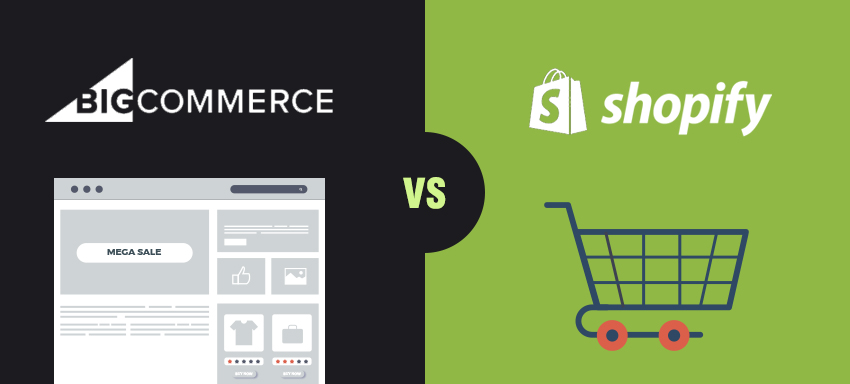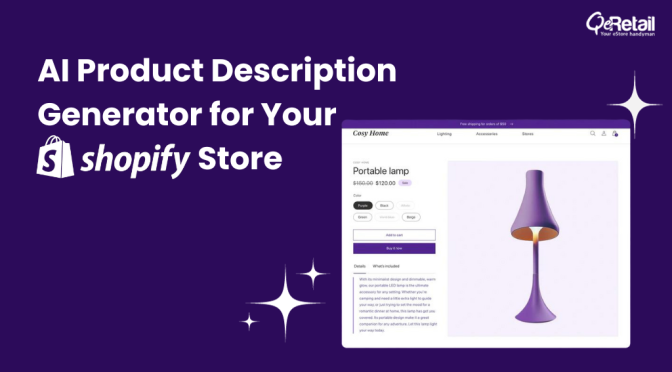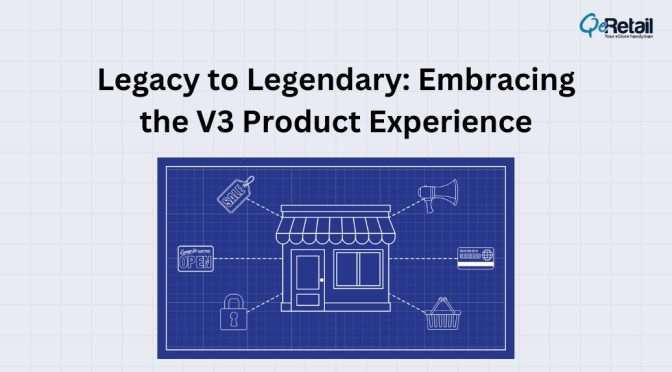BigCommerce vs Shopify – This game of ‘verses’ has always been the talk of eCommerce world!
Shopify or BigCommerce? Choosing between the two is quite a dilemma! The question pops up whenever an eCommerce store is on the verge of emergence! Both the SaaS hosting solution providers are different yet similar in their own ways. Via this post, we’ve tried to compare the two in an as objective way as possible. The decision does not rely on just the themes or the pricing; there’s much more to it. We’ve covered aspects that are important for eCommerce businesses before landing their choice on one. Let’s get started…
Table of Contents
Pricing – BigCommerce vs Shopify
Pricing is an aspect that nobody gives all the attention to, but do not neglect either! Especially when we talk about SMBs (small and medium-sized businesses), it holds importance to compare the month/annual plan prices. When we talk about BigCommerce vs Shopify price comparison, they aren’t at afar difference to one another, BUT the features are!
BigCommerce Pricing
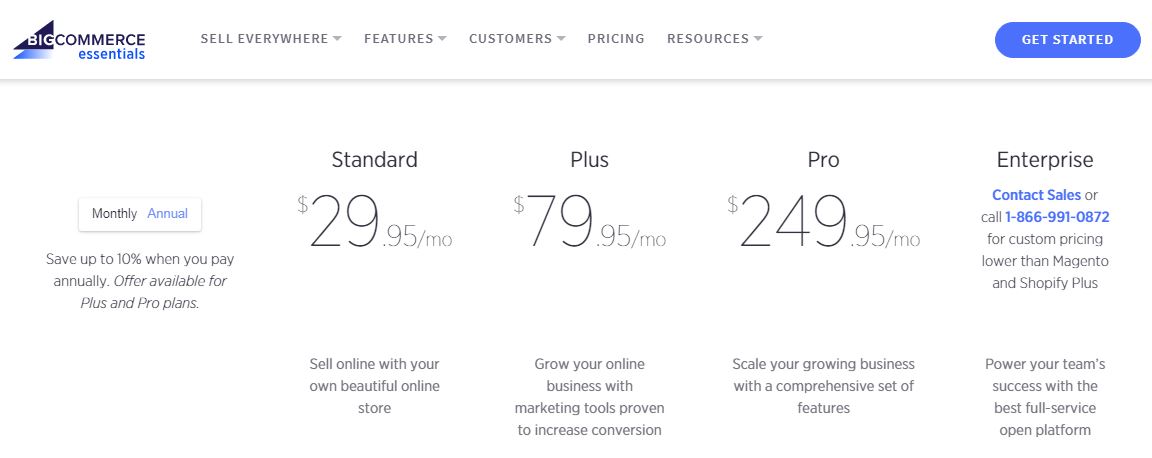
BigCommerce sums it all up with its four plans a) Standard b) Plus c) Pro and d) Enterprise.
These all are monthly charges of the plans where a provision of annual payment with a discount is there too. BigCommerce plans are as follows:
Standard – basically lets you set-up and run your eCommerce store without any marketing features added to it.
Plus – facilities to set-up, run, optimize, market, and grow your online store under one roof.
Pro – is the plan where the eCommerce store is up and running with the ability to analyze and track the progress of marketing efforts. This has features that can boost online conversions.
Enterprise – is designed for the eCommerce businesses which has tons of products and sales. Basically, for the online stores having product categories in hundreds and sales in millions!
The simple bifurcation of BigCommerce’s pricing plans is easy to understand and opt for! It also has a separate tab as ‘enterprise’ which they’re marketing in a different way. Check the BigCommerce Website for ‘enterprise’ details.
Shopify Pricing
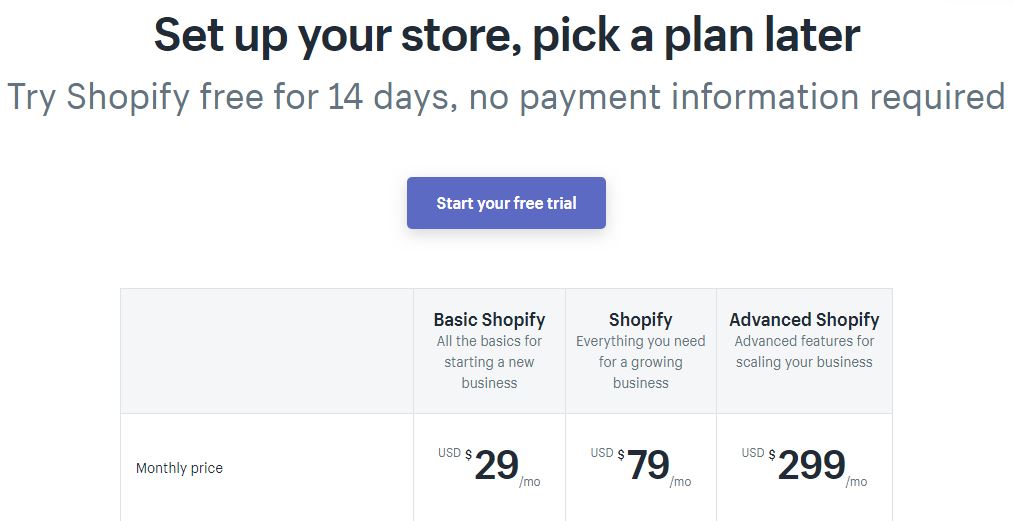
Shopify offers three plan bifurcations and that are, a) Basic Shopify b) Shopify and c) Advanced Shopify. This too has a discounted annual and 2-year payment model. All three plans provide almost similar services as BigCommerce. Here, the plans have two more variants to it as ‘Shopify Lite’ and ‘Shopify Plus’.
Shopify Plus has enterprise-level solutions designed for big eCommerce players and its prices vary from business to business. (Same as BigCommerce ‘Enterprise’)
The additional plan Shopify is providing is its ‘Lite’ variant! This one is for the businesses that need buttons for selling from their Facebook stores or existing websites; an embeddable widget. (not a functional eStore)

Like BigCommerce ‘Enterprise’, the ‘Shopify Plus’ comes without a specified price. Visit the Shopify Website for the details.
Advanced Shopify vs BigCommerce Pro
Shopify and BigCommerce majorly provide plan variants with a negligent price difference of 95 cents. The only plan with a $50 disparity is here in their Advanced and Pro versions. The comparison touchpoints can be discussed as below,
- Shopify Advanced plan offers up to 74% shipping discount in comparison to BigCommerce Pro’s 68% average shipping discount.
- Shopify has ‘no sales bar’, as their other plans wherein BigCommerce caps up to $400k annually on their Pro Plan.
- Shopify Advanced offer ‘advanced report builder’ for its $299 merchants wherein BigCommerce merchants need to buy separate reporting advancement for its plans.
- BigCommerce has an upper hand with a provision of unlimited staff accounts on all its plans wherein Shopify lets you create only 15 staff accounts even in its Advanced plan.
All in all, Shopify offers most features in its ‘Shopify’ plan as it does in its ‘Advanced Shopify’ variant. Whereas BigCommerce Pro charges $50 less exclusively for high-end online merchants who want higher online sales limit. There’s a reason why ‘Shopify Plan’ and ‘BigCommerce Plus’ are the most popular for both platforms! The features are almost similar only with the above-mentioned exceptions.
Recommended: Launching a Shopify store? 10 Must-have apps
The Pricing Comparison
More or less, the pricing plans that Shopify and BigCommerce offer has no difference (except for the 95 cents). So if we talk about the monetary thing, they’re almost at par! As we mentioned above, what matters is not the price of the plan but what comes with it – features. Let’s move towards comparing BigCommerce vs Shopify eStore features that come with these plans.
Features Comparison – BigCommerce vs Shopify
Shopify and BigCommerce both have similar pricing models, but what really makes one win over another is their feature offerings! Let’s dive into that.
When we compare the BigCommerce Standard vs the Shopify Basic ($29 and $29.95 respectively), a clear winner is BigCommerce with the extra in-built eCommerce feature offerings like,
- ratings and review system
- gift cards
- reporting functionality
- real-time carrier shipping quotes
Though both Bigcommerce and Shopify have no number cap on selling products, the above-mentioned eCommerce features; emphasizing the ‘rating & reviews’ feature more, are really important. In Shopify too one can integrate these services, but with the help of free Shopify app or other third-party apps, whereas BigCommerce provides them hassle-free!
- It is not all good-times with BigCommerce Standard plan though. A sales limit of $50,000 per year applies to BigCommerce standard plan whereas Shopify has no such cap. That’s not it, an essential feature of winning back almost converted customer with ‘abandoned cart saver’ (mailing service) feature is available with Shopify entry-level plan, which BigCommerce offers only to their $79.95 and above subscribers.
Overall, if we talk about BigCommerce vs Shopify feature comparison, clearly BigCommerce offers notably more eCommerce store optimization features. Shopify wins us back at its ‘Cart Abandonment Emails’ Feature and no sales limit. Here you need to decide for your eCommerce store that what you can let go of.
Recommended: Launching a Bigcommerce store? 5 Must-have apps
Cart Abandonment Recovery – Shopify vs BigCommerce
BigCommerce and Shopify both provide Cart Abandonment Recovery options, but there are a few catches that you need to go through before choosing a platform.
- The major and probably the most important difference between Shopify and BigCommerce’s cart abandonment recovery feature is its availability on all the plans. Shopify provides this feature to its most basic plan subscribers whereas BigCommerce only has it for its ‘Plus’ plan merchants.
- Shopify and BigCommerce both have third-party apps for cart abandonment recovery emails (paid and free) for the merchants and the manual email sending provision is there too.
- Secondly, Shopify has 5 time-intervals to choose from before sending the abandoned checkout email and that is,
- Never (You can still manually send an email to customers)
- 1 hour later
- 6 hours later
- 10 hours later (default)
- 24 hours later
BigCommerce, on the other hand, has only 2 interval variant options of 1-23 hours or 1-10 days after the order is abandoned respectively.
The Verdict – Shopify vs BigCommerce, Cart Abandonment Recovery
Clearly, we can derive how handy and hassle-free it is to utilize the ‘Cart Abandonment Recovery’ feature better with Shopify. BigCommerce’s major set back is not having this feature for its initial plan and the time interval option.
eCommerce SEO – Shopify vs BigCommerce
For any eCommerce store, visibility is the prime factor. You should be seen to sell!
Both Shopify and BigCommerce allows eCommerce owners to optimize their store with basic but pivotal SEO features. Meta Tags and URL are the most common yet essential ranking factors which both the platforms emphasize at the time of product listing itself. We tried taking a free trial on both BigCommerce and Shopify for better understanding, and here are the screenshots of SEO optimization features on both the platforms.
Shopify SEO Feature Screenshot
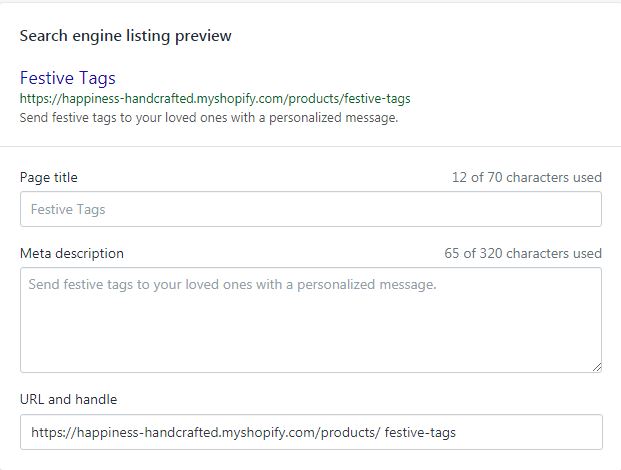
BigCommerce SEO Feature Screenshot
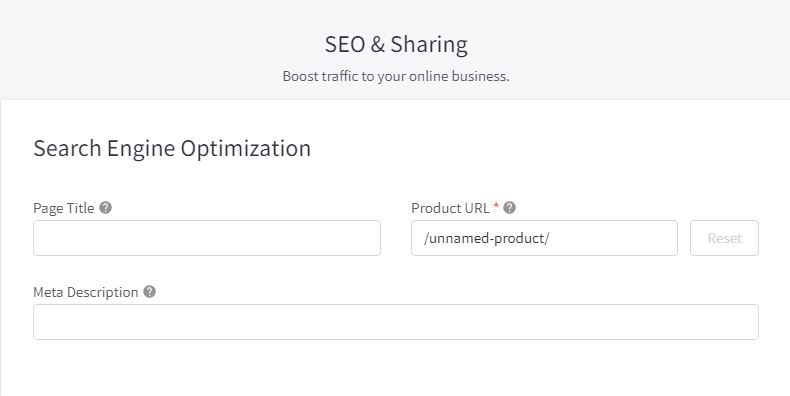 Blog Section – BigCommerce vs Shopify
Blog Section – BigCommerce vs Shopify
An integral part of organic traffic is the website’s blog section. The frequently updated blogs pull more traffic as they establish good credibility in the eyes of the search engine bots. Here, both platforms provide the basic blog section for eCommerce stores. Shopify’s blog section interface, however, is more user-friendly and easy to understand. Both provide SEO details for each blog post with a specific title and meta tags where Shopify wins the show with defined character count.
The Verdict – Shopify vs BigCommerce SEO
They’ve taken care of the basics that help in product search engine rankings. Moreover, another SEO optimization factor ‘Blog’ is also covered on both platforms. Regularly updated blogs play a major role in the website’s search rankings.
But, if we dig a little deeper for the SEO part, the key findings mentioned below changes the whole eCommerce SEO game:
- The URL customization in Bigcommerce is not restricted to any categorization or product list. It lets you bend the URL terms the way you want which Shopify lacks. On Shopify, /products/ and /collections/ are enforced. BigCommerce allows full editing of URLs. a major SEO factor in terms of the Google search algorithm.
- The robots.txt files block certain pages for Google bots. The dynamic pages such as carts and search results should take advantage of this feature. Shopify doesn’t allow edits to these files whereas BigCommerce allows all sorts of modifications for your eStore.
- BigCommerce merchants can make the most out of its in-built Google AMP-enabled themes. Shopify users need to use third-party apps for the same feature. This one here is a major feature eCommerce stores can’t afford to overlook!
With these pointers, the SEO scenario seems to change and reclining towards BigCommerce. Apart from standard SEO settings, BigCommerce wins big in eCommerce SEO.
Transaction Fees & Credit Card Fees – BigCommerce vs Shopify
Transaction Fees Comparison
When we take a glance at the plans they showcase, the tabs of transaction fees look far more satisfying than it is! BigCommerce and Shopify both claim for a 0% transaction fees on the products sold. Here, the case is true for BigCommerce as it DOES NOT charge any transaction fees with any of its plans. Whether you go for a Standard plan or choose a Pro plan on BigCommerce, there’s no discrimination and the transaction fee is 0%. The default BigCommerce payment partner is Paypal and due to the arrangement, the convenience of no transaction fee is applied to its merchants.
On the other hand, Shopify shows a 0% transaction fee option but the twist is ONLY when you use their payment gateway ‘Shopify Payment’. If you wish to use other gateways, the transaction fees differ from plan to plan. It is 2% for ‘Shopify Lite’ and ‘Basic Shopify’, 1% for ‘Shopify’ and 0.5% for the ‘Advanced Shopify’ plan. On another note, Shopify Payment is not available for all the regions yet. Look out for the list of countries where Shopify Payment is available, else, you need to pay for other payment gateways as they charge.
Credit Card Fees Comparison
Apart from the transaction fees, one more charge that eCommerce store owners should be concerned about is the credit card fees. For software and system companies that allow customers’ credit card usage charge some amount from the merchants. Those fees are different in both Shopify and BigCommerce’s cases.
Shopify Credit Card fees are as follows:
- Shopify Lite: 2.9% + 30c per transaction
- Basic Shopify: 2.9% + 30c
- Shopify: 2.6% + 30c
- Advanced Shopify: 2.4% + 30c
BigCommerce’s recommended credit card processing partner is Paypal. Credit card rates using this arrangement are as follows:
- Bigcommerce Standard: 2.9% + 30c per transaction
- Bigcommerce Plus: 2.5% + 30c
- Bigcommerce Pro: 2.2% + 30c
- Bigcommerce Enterprise: 2.2% + 30c
(For Shopify and BigCommerce both, the mentioned rates are for the U.S. merchants. Visit country tabs on their official websites for specific details)
The Verdict – Shopify Pricing vs BigCommerce Pricing
As clear as it looks, BigCommerce comes out as a promising, convenient, and economical option than Shopify. The pricing comparison of credit card and transaction charges has BigCommerce as its hero. In both cases, BigCommerce charges considerably less than that of Shopify.
eStore Themes and Templates – BigCommerce vs Shopify
How the eStore looks, is definitely the major concern for any owner! After all, aesthetics and visual appeal matter the most! When we talk about the eCommerce store setup, both the platforms provide enough theme variants to choose from.
Free Templates
“Shopify has 10 free themes with 22 variants to it,
whereas BigCommerce, with a recent update, raises the bar with 12 free themes and 36 variants”
Paid Templates
“Shopify offers 64 paid themes with more than 170 styles to it,
Whereas BigCommerce provides 132 paid templates with more than 300 styles”
Detailed Template Comparison
If we straight go by the numbers, sure BigCommerce shows a bigger picture in terms of theming options for both paid and free categories. But, if we go by the actual amount of variations in styles, Shopify has better provisions. BigCommerce theme variants are basically with minor changes of colors and image resolution, wherein Shopify has more styling variations in a single theme. This is the major comparison difference that stood out when we compared both!
Additional Points
- Shopify themes represent a more modern approach when it comes to designing, and on the other side, BigCommerce is with professional-looking and contemporary theming.
- Another major comparison point that we observed is the ‘AMP Enabled’ themes by BigCommerce. With Google collaboration, they have a separate category for AMP-enabled themes which Shopify lacks. Of course with the help of tools, developers, and Shopify App Center, this arrangement can be done, but embedded enablement of AMP is quite a star for us. With search engines providing major preferences to AMP websites, having an eCommerce store on this category sure helps the rankings!
- The paid themes on both the platforms are no doubts come with more styling, optimizing, and layout options. But we recommend free themes more as there are ample amounts of variants you get in here too.
- A point that is worth noting is the way Shopify has designed its theme offering page. With various styling choices, they’ve made sure to point out navigation, product page, homepage, marketing, and other essential aspects that affect an eCommerce store. Anyone new to the online biz. the world would get the most out of Shopify’s simple, hassle-free eCommerce store setup mechanism.

eCommerce Fraud Prevention – BigCommerce vs Shopify
Fraud prevention plays a major role when it comes to chargebacks. Especially for the small and medium-sized businesses, the suspicious order detection is essential.
Comparison
- Shopify has an in-built functionality of fraud-analysis which uses machine learning algorithms to help bring suspicious orders to your attention. For the Basic Shopify plan, then fraud analysis includes indicators and support for third-party fraud apps. While the Shopify plan and higher, or the merchants using Shopify Payments on any plan, the fraud analysis includes indicators, support for third-party fraud apps, plus the fraud recommendations. Take a look at the screenshots for ‘Basic’ and ‘Shopify + higher plan’ fraud prevention facility.
(For basic Shopify plan)
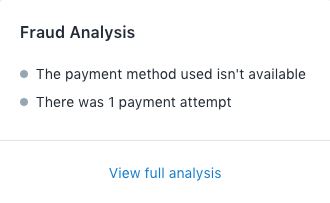
(For ‘Shopify’ and further variants)
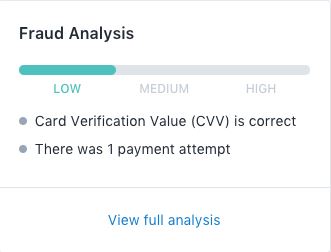
- On the BigComemrce’s hand, fraud prevention functionality is only available through third-party app integrations. They recommend two of the apps (Signifyd and Klarna) for eCommerce fraud prevention while numerous other app integrations are already available on their app store.
By this offering, we can tell that Shopify has an upper hand when it comes to yet another integral part of the online shopping industry. With the Cart Abandonment feature for all the plan variants and basic Fraud Prevention functionality too, BigCommerce sure miss out on some prime areas.
Drive traffic and generate sales with Shopify SEO Services
Ease of Use – Shopify or BigCommerce
When it comes to setting up an eCommerce store, the ease of access is something that these hosting platforms should never miss out on. Most of the time, people who have negligent to basic knowledge about HTML, JAVA and other coding languages come on board. This is the reason why any hosting solution provider should keep the features in a way which any layman can easily adapt. Before we put out our points, let’s look at what other comparisons have to say and what the Google trend shows for BigCommerce vs Shopify.
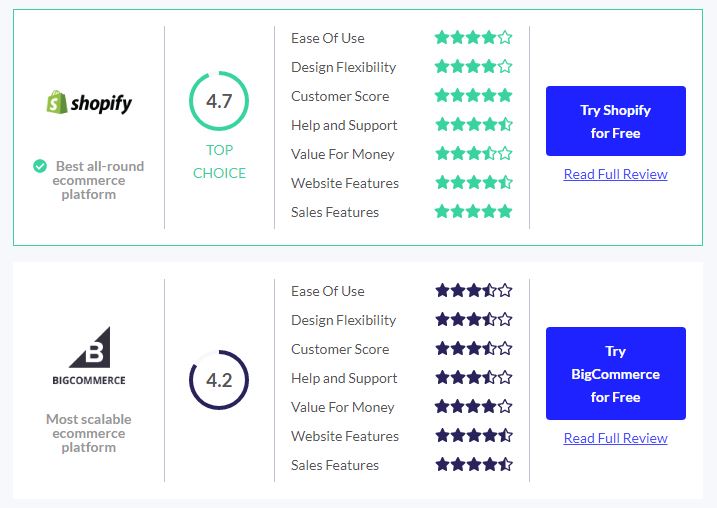
(Comparison analysis from Website Builder Expert)

(Comparison analysis from Merchant Maverick)
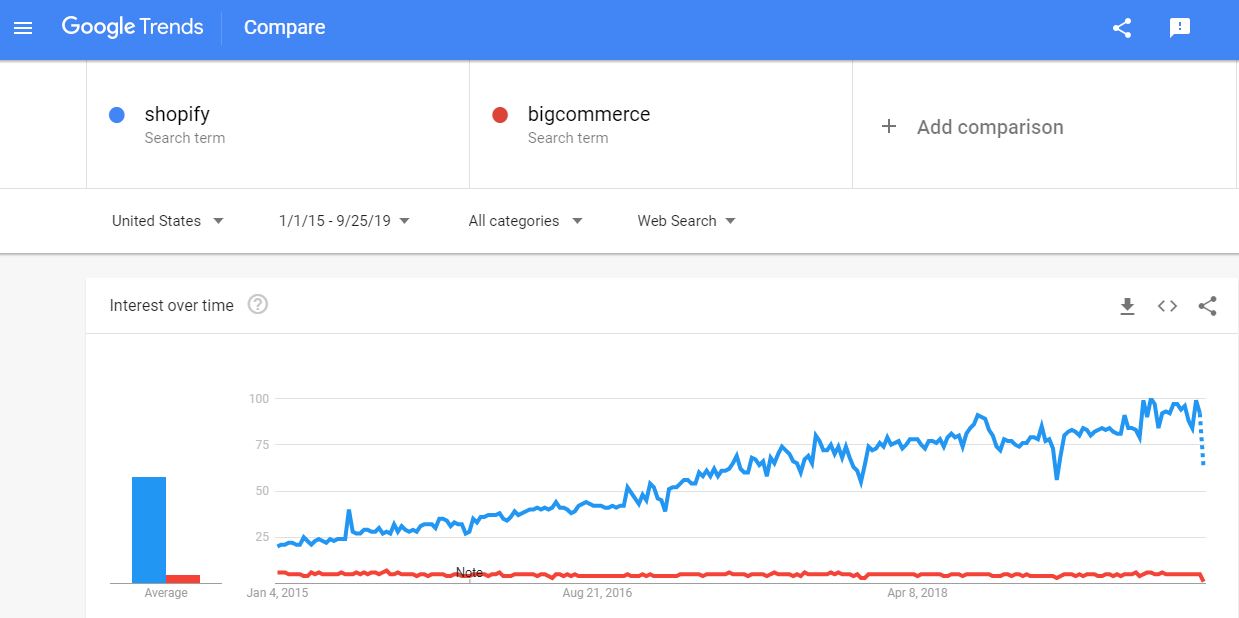
(Google search trend comparison for Shopify and BigCommerce from 01/01/2015 to 09/25/2019 {~ 5 years})
- Shopify gives examples and previews at most places when it comes to the eCommerce store features. Be it the SEO section, Blog section or the Fraud Prevention provision, merchants can get a clear idea for the feature that they are editing. BigCommerce features are almost similar to what Shopify is providing, but the ease of use is a missing element.
- Moreover, when we browse through the guides for setting up the eStore, Shopify clearly has more simple, detailed, and easy-to-understand explanations of what the merchants might look for.
- BigCommerce is considered quite difficult to use when tried by beginners, whereas, setting up an online store on Shopify is fast and uncomplicated.
App Integration – Shopify or BigCommerce
‘App Store’ with third-party integrations is available on Shopify and BigCommerce both. The number of Apps present, however, is what changes the game. If we put it in a single sentence then it can go like, ‘For BigCommerce’s 100 applications, there are Shopify’s 1000 apps available for your eCommerce Store’.
The catch here is, BigCommerce offers more built-in features than Shopify for the need for an outside integration, but any which way, Shopify has an ocean full of apps that BigCommerce doesn’t. But not to forget, a vital integration that BigCommerce offers and Shopify lacks is the ‘Official MailChimp Integration’. Though there are many workarounds after the Mailchimp Shopify breakup; the official integration to one of the most user-friendly email marketing platforms sure makes a huge difference.
Extra Pointer
A crucial aspect when we compare Shopify vs BigCommerce is the mobile app availability. With all the generations turning to smart devices, how can we not mention this?
- Shopify has a mobile application for merchants who want to run and scale their eCommerce store from their phones. The Shopify App allows us to manage basic aspects of the eStore like fulfilling the orders, add/edit products, and view reports.
- BigCommerce, on the contrary, does not provide any official mobile app for merchants. And, the third-party smartphone apps available, can’t expect support from BigCommerce.
We have a clear winner here! It’s not all wrong to say that Shopify offers more comprehensive and official options when it comes to managing the eStore from a smart device.
Upgrade to BigCommerce Stencil and get a New Custom Design for your online store @ No Cost
Final Word
Is BigCommerce better than Shopify? Or Which is better, Shopify or BigCommerce? These questions are natural but not totally justifiable. Both eCommerce hosting solution providers have their own star offerings and get low at some point or the other than the rival. The final choice always stays with the eStore decision-makers. We compared BigCommerce and Shopify and the above story is what we want to present to you. Now the ball is in your court to come up with a solution that better suits your eCommerce industry, preferences, and end goal. We’re eCommerce handymen and we’re here to make your online store existence smooth! Keep visiting the blog section for more such comparisons and insights!
Happy eCommercing till then!


